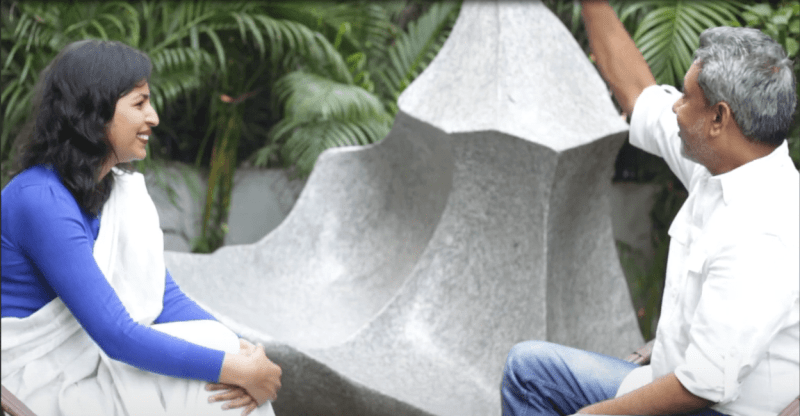
Alwar Balasubramaniam or Bala, as he is fondly referred to by his friends, slides the touchscreen of his phone to show me image after image of clouds, the ones he chases through the lens of his phone’s camera when he is not secretly collaborating with them to create works of art, or should I say works of nature. Bala speaks about them with a fascination that exceeds the kind he expresses even when describing his own works.
As we sit in the garden of Talwar Gallery in New Delhi, which is now home to one of Balasubramaniam’s sculptures, flipping still further through the folder of images on his phone, Bala shows me images of his studio in Tirunelveli, Tamil Nadu, from where he originally hails and where he has finally moved back again. He speaks about training himself in architectural practices and traditions having self-built not just his studio but also a school for little children over a period of five years. Talking about how hot the place gets, he explains how he insulated the walls of the studio. The idea came from drawing a line across the equator on a world map, studying the native practices and structures used by cultures and countries south of the equator to insulate all kinds of buildings and architectural structures. For Bala, life, nature, art and most other things aren’t so different from each other.
Speaking about his two recently concluded solo exhibitions, Liquid Lake Mountain and Becoming Nature, at Talwar Gallery in New Delhi and New York respectively, he says he does not work for an exhibition. In fact, his most recent works involved working with the phenomenon of ‘evaporation of pigments’, which as Bala describes, depends ‘long or short on how the day is’. Emphasising the role of nature in his art and the marks that natural forces leave behind to create works, Bala says, “those marks are the record of the days.”
Describing his process, Bala says, “I started in the beginning with witnessing it, facilitating, setting up the environment. It’s like putting a seed, you water it, prepare the ground and everything, but you don’t really work on the seed to come out. You work around the seed. Similarly, the work has an environment where the liquid could stay and it is exposed to sunlight and it’s not too dusty and it has a filter on top, all those things. Later I started interacting with it. So, in the later works, I tried to control the marks”. Bala works with nature as a collaborator, alchemising materials and letting the process of creation in turn alchemise him.
Perhaps then the ethereal quality of Bala’s works seems to be a consequence of artistic distillation and a practice that exists outside of deadlines. It’s like this precarious balance between the addition of elements, both natural or artistic, and a simultaneous subtraction of what is no longer needed. What is left is an innate sense of flow, albeit fleeting. Where this flow stems from is a mystery. As Bala puts it, “Art-making is a by-product of life rather than an ultimate destiny”.
-Sukanya Garg